Comprehensive Insights into Wulfenite Crystals
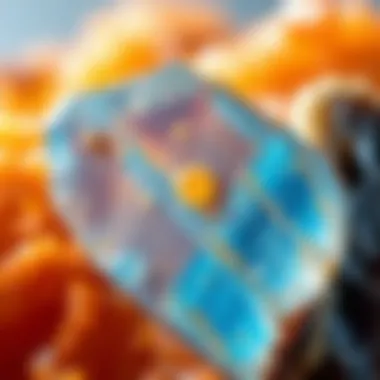
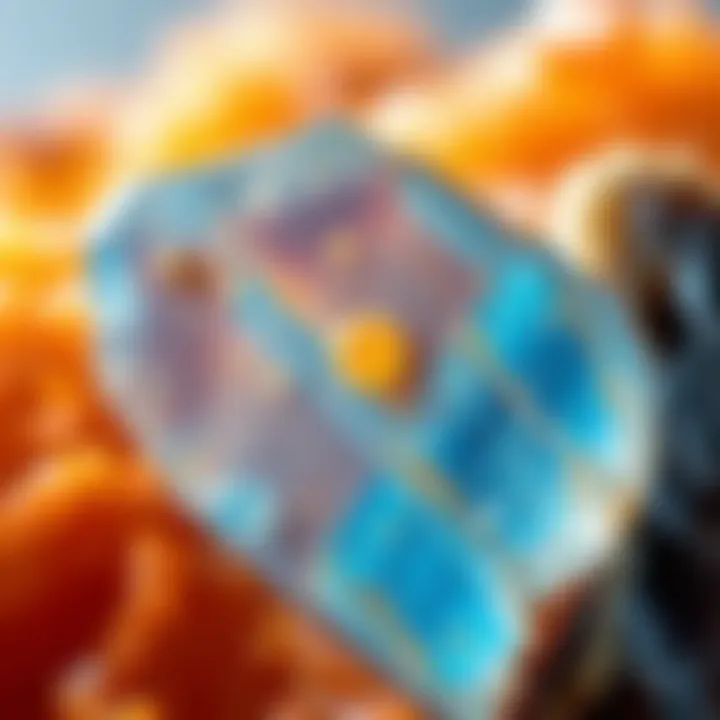
Intro
Wulfenite crystals, often regarded as one of the gems in the mineral collecting community, are not only striking in their appearance but also rich in geological and cultural narratives. This mineral, primarily composed of lead molybdate, exhibits a beautiful array of colors, mostly shades of yellow, orange, and sometimes green, which can captivate collectors and enthusiasts alike. Understanding wulfenite requires a closer look at its formation processes, distinctive properties, and the contexts in which these minerals develop.
Collectively, wulfenite’s unique characteristics and the environments in which it forms chapter a long and fascinating story that resonates with amateur hobbyists and seasoned mineralogists. Beyond mere aesthetics, its historical significance sprawls over centuries, touching aspects of mining, usage, and even symbolism within various cultures. In this article, we will journey through each intricate detail of wulfenite, from how it forms within geological environments to essential guidance for identifying and caring for pieces within a collection.
By the end, readers will not only appreciate the beauty of wulfenite but also its role in the broader context of mineralogy, thereby enhancing their collecting experience.
Intro to Wulfenite
Wulfenite is a captivating mineral, known not just for its aesthetic appeal but also for its significance in geological studies and mineral collecting. In this section, we’ll uncover what wulfenite is, why it matters, and how it situates itself in the broader context of mineralogy. For aficionados and hobbyist collectors, understanding the intricate details of wulfenite enhances appreciation and knowledge, making it a key topic in the realm of earth sciences.
There’s much to be said about this mineral, from its physical attributes to its formation process, and its allure among collectors. It's not just a pretty piece of rock; it’s a story waiting to be told, rich in history and cultural meaning.
Definition and Overview
Wulfenite is a lead molybdate mineral with the chemical formula PbMoO4. Typically found in a vibrant shade of yellow or orange, its striking colors and unique crystal formations make it a sought-after specimen among mineral enthusiasts. This mineral crystallizes in the tetragonal system, leading to various forms and habits, such as tabular crystals or plates, that can be remarkably photogenic.
In more technical terms, wulfenite exhibits a hardness of 2.5 to 3 on the Mohs scale, which makes it softer than many common gemstones. This unique hardness level indicates that it can be difficult to maintain without proper care, but it also presents an intriguing dichotomy between fragility and beauty.
Another defining characteristic is its transparency, which varies from completely clear to translucent depending on impurities and structural variations in the crystals. This visual flexibility not only enhances its aesthetic value but also revs up interest among collectors and geologists alike.
Historical Context
The discovery of wulfenite dates back to the 18th century. First described in 1845 by the Austrian mineralogist Franz Xaver von Wulfen, from whom it derives its name, the mineral reflects a challenging past, often sourced from lead mines. Historically, it has been linked to the Technical Age and various mining booms, especially in regions like Mexico and the United States, which have been instrumental in yielding rich deposits.
In the 19th and early 20th centuries, wulfenite was not only a collector's item but also played a role in scientific research. It has helped mineralogists better understand molybdenum's role in geology and mineralization processes. Understanding wulfenite’s history and its geological implications contributes significantly to mineral enthusiasts and professionals alike, providing valuable insights into mining practices and mineral distribution.
Exploring wulfenite not only enriches our knowledge base but also reveals the interconnectedness of natural sciences, cultural heritage, and the evolution of earth materials through time.
In summary, wulfenite’s unique properties and fascinating historical background make it more than just a mineral; it’s a testament to nature’s artistry and the human passion for discovery, teaching us about our planet and enhancing our collective understanding of mineral resources. Its place in both popular culture and professional mineralogy offers a rich ground for exploration and appreciation.
Geological Formation of Wulfenite
Understanding the geological formation of wulfenite is foundational in appreciating its unique characteristics and the environments in which it is found. This mineral, primarily composed of lead molybdate, emerges through specific processes and conditions that offer insights into not only its physical properties but also its significance within the greater context of mineralogy. Knowing how wulfenite crystallizes and the types of geological settings conducive to its formation can enhance collectors' knowledge and appreciation of this striking mineral.
Formation Processes
Wulfenite primarily crystallizes in oxidized zones of lead deposits, usually formed through hydrothermal processes. Imagine a hot soup of minerals and elements bubbling away deep in the Earth. As these solutions rise and cool, wulfenite begins to take shape, transforming from a liquid state to solid crystals. The conditions must be just right: a higher pH, a lack of water, and the right temperature can all make a difference.
Here are some key points regarding the formation processes:
- Oxidation: The presence of lead ore in an oxidative environment leads to the formation of lead hydroxide, which eventually transforms into wulfenite.
- Precipitation: As temperatures drop during the cooling phase, wulfenite begins to precipitate out of the mineral-rich solution, forming flat, tabular crystals typically displaying a range of stunning colors from orange to yellow.
- Time Factor: Crystallization is not instantaneous. It takes years, sometimes millions of years for these processes to yield the perfect specimens coveted by collectors.
In summation, the formation processes of wulfenite represent a complex interplay of chemical, physical, and environmental factors, each contributing to the unique aesthetic qualities and rarity of this mineral.
Associated Minerals
Wulfenite does not stand alone; it often forms alongside several other minerals, forming an intricate web of relationships that reflect the geological conditions of their environment. Collectors often find wulfenite in association with minerals such as:
- Molybdenite: As the source of molybdenum, it frequently coexists with wulfenite, providing clues to its geological origins.
- Galena: This lead sulfide mineral is a common companion, illustrating the link between wulfenite and lead deposits.
- Fluorite: Known for its vibrant colors, fluorite can often be seen alongside wulfenite, enhancing the aesthetic appeal of mineral collections.
- Cerussite: A secondary lead mineral that sometimes forms near wulfenite deposits, showcasing the mineral's versatility and the extensive variety of environments from which it can be sourced.
This variety of associations emphasizes the complexity of geological formations and how they can produce multiple valuable specimens in a single location.
"The beauty of wulfenite lies not only in its striking appearance but also in the fascinating geological narrative it represents, shaped by elements, time, and transformation."
Physical and Chemical Properties
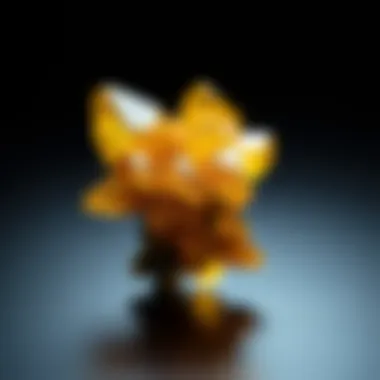
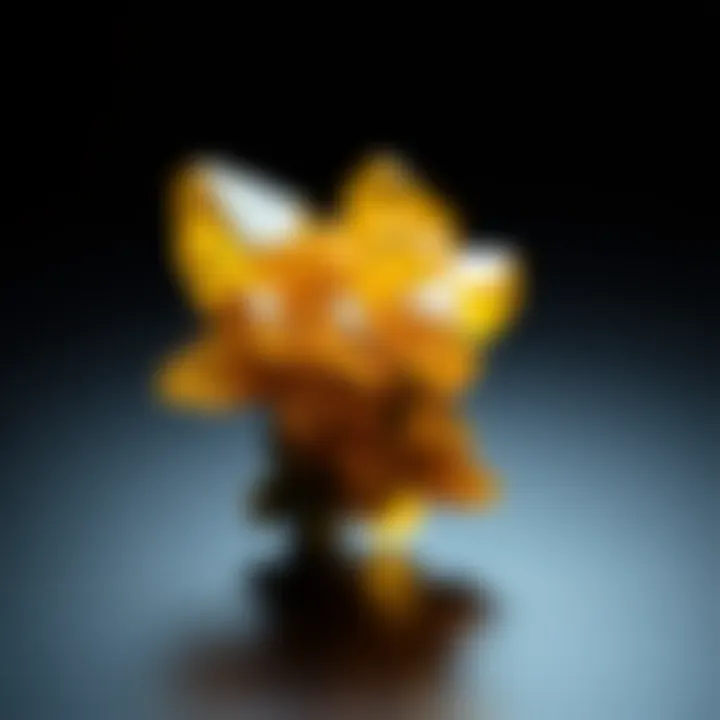
Understanding the physical and chemical properties of wulfenite is crucial for collectors and enthusiasts alike. These attributes not only define the mineral's identity but also influence its desirability and handling characteristics. This section will outline key aspects, including the crystal structure, color variations, and hardness, shedding light on the distinct features that make wulfenite a fascinating specimen in the world of geology.
Crystal Structure
Wulfenite possesses a unique crystal structure. It falls under the tetragonal system, characterized by its elongated, prismatic crystals that can form into various habits. Often, these crystals resemble thin tabs or plates, sometimes stacked on top of each other. This structure can lead to interesting optical effects in certain specimens, allowing light to play through and create stunning visual displays.
The lattice of wulfenite is composed mainly of lead and molybdenum, which contributes to its overall stability and formation. Collectors should note that the arrangement of atoms in wulfenite is essential for its other physical properties, such as cleavage and durability. Recognizing the arrangement helps in identifying authentic specimens as fakes often lack the genuine crystalline integrity.
Color Variations
Wulfenite is renowned for its vibrant color palette, ranging from yellow to orange to green. These hues are primarily influenced by the mineral's iron content and the presence of trace elements. A bright, lemon-yellow specimen might catch one's eye in a collection, while a rare green or blue variation can be the crown jewel for some collectors.
Beyond mere aesthetics, understanding these color variations is vital for authenticity. Many imitations attempt to mimic the vivid colors of natural wulfenite yet often lack depth and richness in their pigments. A discerning eye can spot the differences quickly once familiar with the typical color spectrum of natural specimens. Furthermore, environmental conditions in which the mineral forms can also lead to subtle shifts in color, guiding enthusiasts in their collection pursuits.
Hardness and Cleavage
Wulfenite's hardness is rated at around 3 to 4 on the Mohs scale, making it relatively soft compared to other minerals. This softness means that wulfenite must be handled with care. It scratches easily, which can lead to unintentional damage during collection or display. Understanding its hardness will help collectors determine proper storage solutions; a careful approach can prevent unnecessary wear and tear over time.
When it comes to cleavage, wulfenite exhibits distinct properties that should be noted. It cleaves perfectly along one direction, creating smooth surfaces that are often incredibly reflective. This characteristic makes certain specimens particularly desirable for display; the light reflection can capture the attention of many. However, it also means that collectors should be aware of how they handle these specimens to prevent breaking, as the lines of cleavage can create weak points in the crystals.
Key Insights: Proper knowledge of wulfenite's physical and chemical properties enhances appreciation for these crystals and informs collectors about best practices in preservation and display.
Varieties of Wulfenite
The exploration of wulfenite varieties goes beyond the surface of mineralogy, digging into distinct features that can shift a collector’s perspective. Understanding these varieties enriches the appreciation of wulfenite crystals and aids in distinguishing them from other minerals. The variations in color, shape, and locality can influence both their desirability and market value, making this topic crucial for any enthusiast.
Common Varieties
When it comes to common varieties, wulfenite typically appears in shades of yellow, orange, or brown. The most recognized and widely sought-after variety is the bright yellow wulfenite from the Los Lamentos region in Mexico. The crystals from here are often tabular, displaying exceptional clarity and sharpness of edges.
Another noteworthy common variety is the orange wulfenite, which, while less prevalent than its yellow counterpart, still commands attention due to its vibrant hue. These specimens often come from various locations, including several sites in the USA. Additionally, there are translucent shades of wulfenite that add to the mineral's allure and make it a delightful subject for both photography and mineral displays.
- Key Characteristics of Common Varieties:
- Bright yellow to orange hues
- Tabular crystal structures
- Sources often include Mexico and the USA
Collectors should be on alert for characteristics like crystal structure as this can indicate quality. For instance, thicker and more well-formed tabular crystals are generally more desirable. Furthermore, conditions of extraction and locality can seriously affect price, with certain areas like Chihuahua holding a higher premium due to scarcity and beauty.
Rare Varieties
On the other end of the spectrum lie the rare varieties of wulfenite, which are not as readily available and often attract a more niche collecting crowd. For example, wulfenite that showcases a striking green hue, though exceedingly rare, has been found in certain deposits within Namibia. The unique coloration is attributed to the presence of lead, creating a visual spectacle that is almost surreal and highly prized among collectors.
Additionally, wulfenite crystals that exhibit unique forms, such as the octahedral or complex morphologies, are rare gems. These forms are not only beautiful but also illustrate the diverse crystallography of wulfenite. Notable finds include specimens from Tsumeb, Namibia, renowned for their exceptional morphology and brilliant colors.
- Key Characteristics of Rare Varieties:
- Uncommon colorations, like green or blue
- Unique crystal forms, including octahedrals
- Sparsely found locations such as Namibia and Tsumeb
The rarity of these varieties often leads to higher market values. Collectors keen on acquiring these specimens should stay connected with exclusive mineral fairs and auction sites, as rare finds typically surface in specialized venues. Knowledge and persistence are key, with a touch of luck thrown in for good measure.
Collectively, the study of wulfenite varieties encompasses both common finds and elusive treasures, each bringing unique elements to the table. With the right information, collectors can make informed decisions while enriching their collections with these remarkable natural wonders.
Locations and Occurrences
Understanding the locations and occurrences of wulfenite crystals is crucial to both collectors and researchers. This section provides insights into where these magnificent minerals form and highlights the significance of their geographic distribution. Specific localities not only influence the aesthetic and physical characteristics of wulfenite but also play a pivotal role in how collectors approach sourcing and valuing these specimens.
Key Localities Worldwide
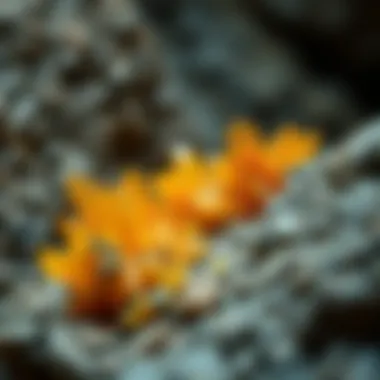
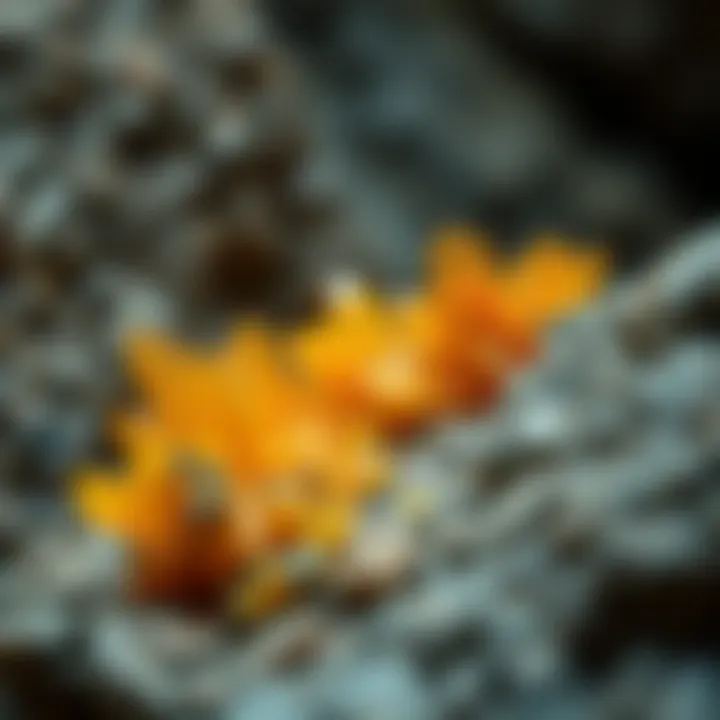
Wulfenite can be found across the globe, but some regions are celebrated for the quality and quantity of their specimens. Here are a few notable localities:
- Los Lamentos Mining District, Chihuahua, Mexico: This site is home to some of the most sought-after wulfenite specimens. The crystals are often vibrant in color, ranging from deep oranges to radiant yellows, making them highly appealing for collectors.
- Blanchard Mine, New Mexico, USA: Renowned for its rich deposits of various minerals, this mine features notably distinct wulfenite that exhibits thick, tabular forms. Collectors admire the unique texture and finish that these crystals possess.
- Tsumeb Mine, Namibia: Tsumeb is legendary in the mineral world for its diverse range of exceptional specimens. Wulfenite found here often displays intricate forms and vivid colors, garnering considerable attention at mineral shows.
- Bachofen Quarry, Switzerland: While not as prolific as other locations, the wulfenite discovered here is exceptional in purity and clarity. Its rarity makes it a valuable find for dedicated enthusiasts.
The allure of these localities lies not just in the physical specimens but also in the stories behind them. Each area has its own historical narrative, influencing how collectors and geologists alike appreciate wulfenite.
Significance of Geographic Distribution
The geographic distribution of wulfenite is more than a map point; it's a reflection of the mineral's environmental and geological context. Several factors influence where wulfenite forms:
- Geological Conditions: Wulfenite typically originates in lead vanadate deposits. Regions with similar geological formations are likely to yield wulfenite crystals. Thus, understanding geography helps predict where to find these minerals.
- Mining Practices: Different regions employ various mining techniques, affecting the preservation and access to wulfenite. For instance, open-pit mining might expose larger areas than shaft mining, leading to increased discoveries.
- Economic Considerations: In areas where mineral collecting is economically significant, local mining laws can shape what is brought to market. Understanding the political and economic climate of a region can inform collectors about the availability and pricing of wulfenite.
As we appreciate these stunning crystals, it is essential to embrace the rich tapestry of geological and human histories that coexist with them. The quest for wulfenite isn’t merely about the hunt; it’s about understanding the world around us, its treasures, and the stories they tell.
"The earth has music for those who listen." – William Shakespeare
Collecting Wulfenite Crystals
Collecting wulfenite crystals holds a unique charm for both novice and seasoned mineral collectors. This fascinating mineral, with its vibrant colors and intriguing crystal formations, stimulates not just an aesthetic appreciation but also scientific curiosity. Gathering wulfenite is about more than just acquiring beautiful pieces; it’s an exploration of geology, history, and sometimes, even personal stories that accompany specimens. With a little knowledge and a dash of patience, anyone can develop their collection into something extraordinary.
Tips for Collectors
If you’re serious about collecting wulfenite crystals, there are several key strategies to maximize your success.
- Research Localities: Start with a solid understanding of where wulfenite is found. Locations like the Ojuela Mine in Mexico and the lead mines near Sterling Hill in New Jersey, USA are infamous for high-quality specimens. Delve into geological surveys and maps to pinpoint active mining sites and notable finds.
- Engage with the Community: Connect with fellow collectors through forums and social media communities. Websites like Reddit (reddit.com) or Facebook groups can provide a wealth of information and tips on where to find specific varieties or upcoming shows and swaps.
- Attend Mineral Shows: Visiting trade shows can be a delightful experience. Not only can you find unique specimens, but you can also interact with collectors and experts, learning from their experiences. Often, these shows feature workshops and presentations that can expand your knowledge further.
- Keep Records: Documenting your collection meticulously can enhance its value over time. Note the provenance of each piece, including its location, date of acquisition, and any outstanding physical characteristics or stories associated with it.
- Invest in Proper Tools: A good magnifying glass or a jeweler's loupe can help you examine potential purchases more closely, allowing you to identify authentic specimens versus imitations.
By following these tips, collectors can create a well-rounded and meaningful collection that reflects both their individual tastes and the rich story of wulfenite.
Avoiding Common Pitfalls
While the world of mineral collecting is thrilling, there are pitfalls that can snag the unwary collector. Here are some to watch for:
- Fakes and Fractures: Wulfenite can be mimicked. Ensure that you’re purchasing from reputable dealers who provide certificates of authenticity when applicable. Always inspect crystals closely for any signs of artificial treatments.
- Overlooking Specimen Quality: Don’t just grab the first piece that catches your eye. Quality matters. Look for combinations of color, size, and crystal form that make a specimen unique. Don’t be afraid to walk away if a piece doesn't meet your standards.
- Ignoring Market Value Trends: The value of wulfenite can fluctuate based on market demands. Stay informed about pricing trends and be cautious of overspending or rushing into purchases without doing your homework.
- Neglecting Preservation: Wulfenite is sensitive to environmental factors. Humidity, temperature swings, and direct sunlight can damage specimens. Be sure to store your collection in a controlled environment to maintain pristine conditions.
- Only Focusing on Looks: While beauty often draws collectors in, remember that the story behind each piece is equally important. Understanding the mineral's geological background will deepen your appreciation and provide context for your collection.
In short, collecting wulfenite crystals can be highly rewarding, but it requires a careful balance of enthusiasm and diligence. With dedication, awareness of common pitfalls, and a passion for learning, anyone can build a collection that stands the test of time and showcases this beautiful mineral's unique heritage.
Caring for Wulfenite Specimens
Caring for wulfenite specimens is vital for collectors who wish to preserve their aesthetic appeal and structural integrity. Unlike some minerals, wulfenite has unique characteristics that require thoughtful handling. Proper care not only ensures the longevity of these crystals but also maintains their qualities that make them valuable—both scientifically and monetarily.
Cleaning Techniques
When it comes to cleaning wulfenite, one must tread carefully. The first step is identifying the nature of the dirt or residue on the specimen. Dust may be easily blown away or brushed off with a soft paintbrush. However, stubborn stains or residues from environment or prior handling can be vexing and require specific methods.
- Gentle Washing: A light wash using distilled water can be beneficial.
- Soft Brushes: For particularly stubborn dirt, use a soft brush. A small, clean watercolor brush works wonders.
- Chemical Cleaners: While many collectors shy away from chemicals, if the staining is extensive, a very diluted solution of mild detergent may work. However, this must be approached with extreme caution. Always test the solution on a small, inconspicuous area first to see if there are any adverse reactions.
- Avoid tap water, as minerals found in it might leave residues.
- Use a soft, lint-free cloth to dab rather than rub; this prevents scratching the crystal's delicate surface.
- It's crucial to ensure the brush is dry and clean to avoid transferring any unwanted materials.
"Because the care given to wulfenite specimens reflects not just the collector's respect for the mineral, but also the potential for future appreciation in the collecting community."
Display Practices
Once cleaned, the next step is displaying the wulfenite specimen properly. Displaying crystals isn't just for aesthetics; it can significantly impact their preservation as well. There are several factors to consider:
- Avoid Direct Sunlight: Wulfenite can fade when exposed to prolonged sunlight. Find a cool, shaded spot to put them on display.
- Secure Display Cases: Invest in a display case. Acrylic cases or glass cabinets not only enhance visual appeal but protect against dust and accidental damage.
- Correct Orientation: The way a specimen is oriented significantly affects its visibility and safety. Displaying wulfenite upright can show off its vibrant colors and unique formations without risking scratches or chips.
- Temperature and Humidity: Keep the display area climate-controlled. Excessive humidity can lead to mineral degradation, while extreme dryness can cause fractures. Finding a balanced environment is key.


In summary, caring for wulfenite specimens encompasses both cleaning and displaying tactics tailored to enhance longevity and appreciation for these remarkable crystals. Each step taken by the collector only adds to the narrative of their piece—a story captured within every facet of the wulfenite itself.
The Role of Wulfenite in Mineralogy
Wulfenite has carved a niche for itself in the world of mineralogy, catching the attention of both scientists and collectors alike. Understanding its role goes beyond just admiring its scenic beauty; it involves recognizing its scientific importance and contributions to geological research. The intricacies of wulfenite's formation processes, coupled with its distinctive characteristics, make it an excellent subject for study and exploration in the field of mineralogy.
Scientific Importance
The scientific significance of wulfenite cannot be overstated. As a lead molybdate mineral, it provides insights into various geological processes. Here are a few key aspects:
- Geochemical Indicators: Wulfenite can act as an indicator of the geochemical environment in which it forms. The presence of wulfenite can suggest the availability of lead and molybdenum in specific geologic settings, predominantly in oxidized environments of lead ore deposits.
- Trace Element Analysis: The study of wulfenite often includes trace elements such as zinc, calcium, and iron. These elements can give valuable information regarding the conditions under which the mineral crystallized and help unravel the history of the ore deposits.
- Economic Value: Besides being an aesthetic specimen, wulfenite holds economic importance. It can serve as an ore of lead to an extent and contributes valuable molybdenum, both of which are significant in various industrial applications.
In essence, wulfenite is not merely an attractive mineral but also a vital player in the broader narrative of mineral studies.
Wulfenite in Research
Research on wulfenite encompasses a variety of fields, ranging from petrology to economic geology. Scholars are continually investigating its unique properties, leading to critical discoveries relevant to geology and material science.
- Petrological Studies: Researchers examine wulfenite's crystal structure and growth patterns. These studies often provide insights into the cooling and crystallization history of mineral deposits. Crystal growth can tell stories of the environments where they formed, including temperature and pressure conditions.
- Mineral Associations: Wulfenite is frequently found in association with other minerals, such as galena and calcite. Understanding these associations helps geologists make sense of the mineralization processes in various ore deposits.
- Sustainability Concerns: With the increasing interest in sustainable mining, researchers focus on how to extract lead and molybdenum from wulfenite without causing extensive environmental damage. Studies in this area explore new extraction methods that might yield economic benefits while minimizing ecological footprints.
"The ongoing research on wulfenite not only enriches our understanding of mineralogy but also shapes future economic strategies in mining and material science."
The exploration of wulfenite in research reflects a blend of aesthetic appreciation and a quest for knowledge, making it a fascinating subject for both enthusiasts and experts. With each new study, the perceptions of wulfenite continue to evolve, revealing more layers to its significance in the mineral kingdom.
Cultural and Historical Significance
Wulfenite, often overlooked in standard discussions about minerals, has a rich tapestry of cultural and historical significance. This mineral, with its unique properties and striking colors, has not only fascinated scientists but has also made its mark in art, jewelry, and various traditional practices. Understanding wulfenite’s journey through different cultures sheds light on its multifaceted role beyond mere mineralogy.
Uses in Art and Jewelry
The vibrant hues of wulfenite, predominantly shades of yellow and orange, have provided inspiration for countless artists and jewelers. Throughout history, different societies have harnessed this mineral to express creativity and craft meaningful works. The choice of wulfenite in artistic endeavors is often related to its distinct representation of earth’s beauty. Artisans utilize its bright colors and crystalline texture to portray nature and symbolize resilience.
- Jewelry: Wulfenite's beauty lends itself well to jewelry-making. Artisans often incorporate this stone in pendants, earrings, and rings, marrying aesthetics with the mineral's perceived energies. It's considered a conversation starter in any jewelry collection, as the stone goes beyond appearance—it connects wearers to geological history.
- Art Projects: Artists inspired by mineralogy sometimes recreate the stunning formations and colors of wulfenite in their works, highlighting the intricate details that define this crystal. Contemporary artists have begun using actual stone pieces within their sculptures, bridging the gap between natural forms and artistic expression.
Additionally, there’s a narrative that accompanies each piece featuring wulfenite. Every expertly crafted jewelry item or artistic representation reflects not only the maker’s vision but also a dialogue about the earth's geologic processes, transforming raw material into objects of beauty.
Wulfenite in Traditional Medicine
Wulfenite has also found itself entwined with traditional medicine systems across various cultures. Although not as scientifically endorsed as other minerals, its history reveals how societies perceived the mineral's benefits.
- Cultural Beliefs: Many indigenous communities associated wulfenite with purification and healing. It's often regarded as a channel to connect with earth energies. Practitioners would sometimes use the mineral in rituals meant to cleanse negative spirits or promote emotional well-being.
- Crystals and Healing: In recent years, the rise of the holistic movement has spurred interest in the purported healing properties of crystals. Advocates claim that wulfenite can enhance creativity and intuition, making it a sought-after stone for individuals engaging in art or performing arts.
Whether viewed from a scientific lens or interpreted through cultural narratives, wulfenite encompasses a spectrum of meanings that enrich our understanding of this mineral. As we continue to explore its significance, we uncover layers of its value extending well beyond its aesthetic appeal.
Epilogue
In closing this exploration of wulfenite crystals, it’s crucial to undersand their multi-faceted significance in the fields of mineralogy, art, and even traditional practices. Wulfenite is more than just a striking mineral; it serves as a bridge connecting nature's beauty and human application. For collectors, its unique traits like vivid coloration and crystal form make it a coveted specimen, adding value to their collections. Understanding how to care for and appreciate wulfenite not only enhances one’s collection but also fosters a greater appreciation for geological diversity.
Summary of Insights
Throughout this article, various aspects of wulfenite have been discussed to provide a rounded perspective:
- Geological Context: The formation processes behind wulfenite shed light on its mineral companion and the environments that yield this crystal.
- Physical Properties: From its crystal structure to its notable hardness, these features determine how wulfenite behaves, impacting both collection and display.
- Cultural Relevance: Wulfenite's role in art and medicine brings forth its historical significance, blending natural science with cultural narratives.
The journey from geological formation to cultural applications paints a vivid picture of wulfenite's role in the natural world and its impact on human endeavors.
Future Prospects for Wulfenite Research
Looking ahead, the study of wulfenite crystals seems ripe for innovation. As mineralogy continues to evolve, researchers are poised to explore:
- Advanced Analytical Techniques: By employing new technologies, scientists may uncover hidden features of wulfenite that have been previously overlooked.
- Sustainability and Mining: With growing concerns over natural resource extraction, discussions on ethical sourcing become essential; how can we balance enthusiasm for collecting with responsible practices?
- Artistic Applications: Broader inquiries into how wulfenite can be utilized in modern art may reveal fresh dimensions of its beauty.
These areas of research push the boundaries, prompting a deeper understanding of wulfenite and its potential futures. As enthusiasts, collectors, and researchers alike engage with this remarkable crystal, its legacy is destined to grow, leading to novel insights and engaging conversations in the years to come.



